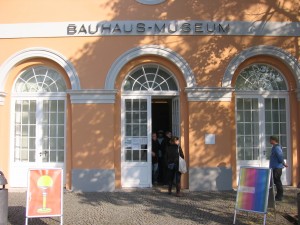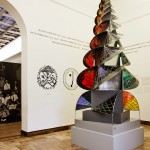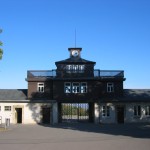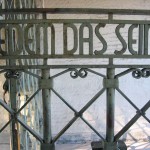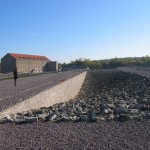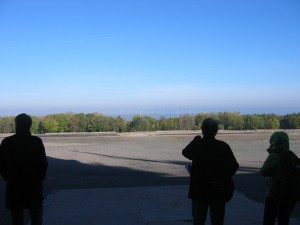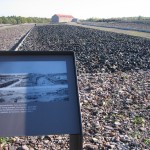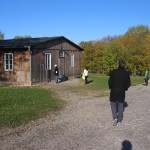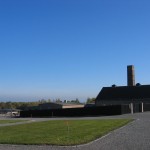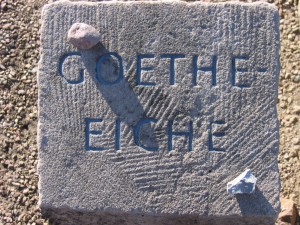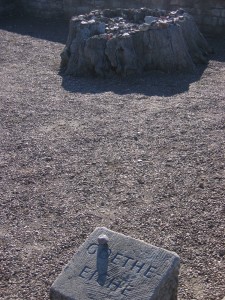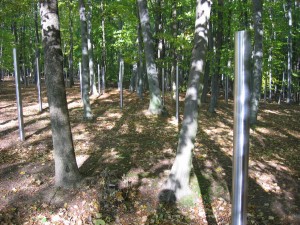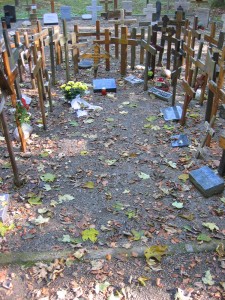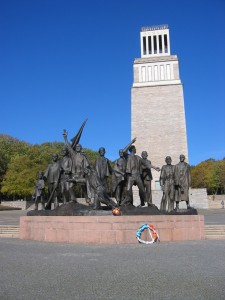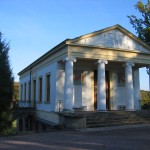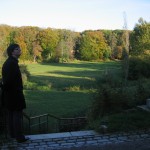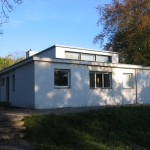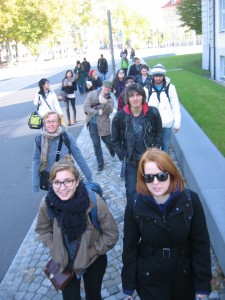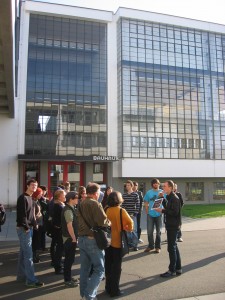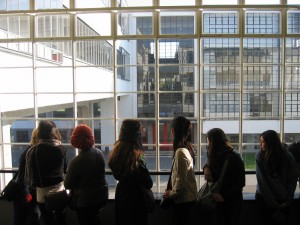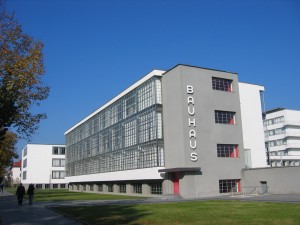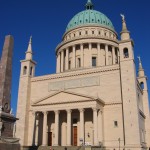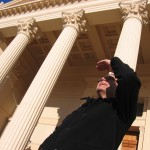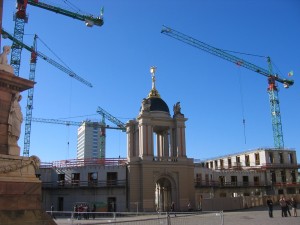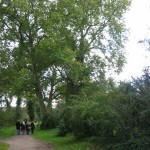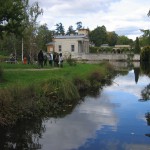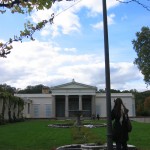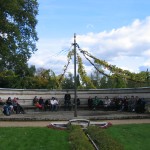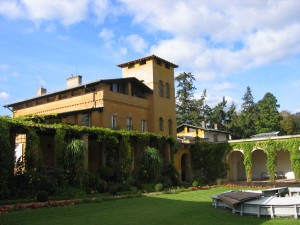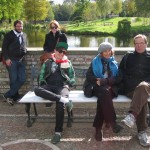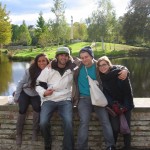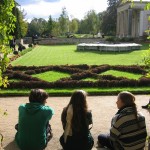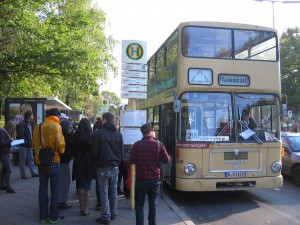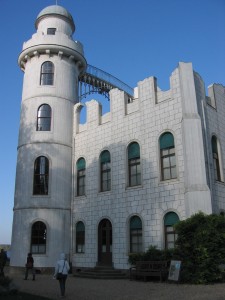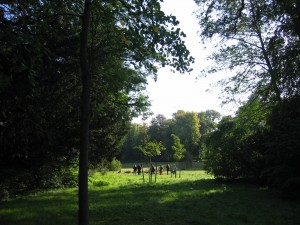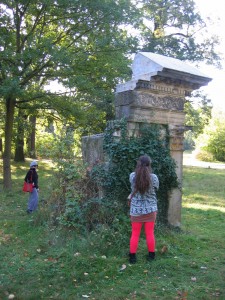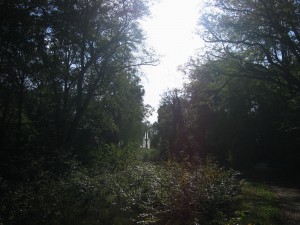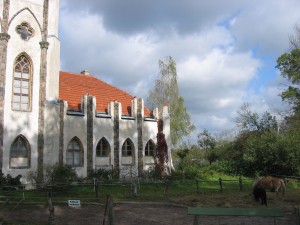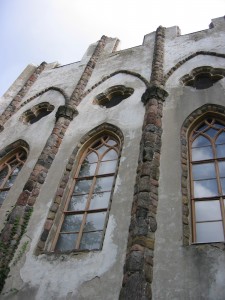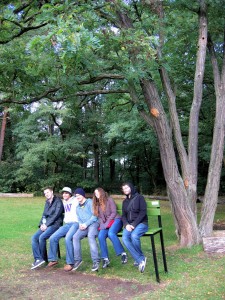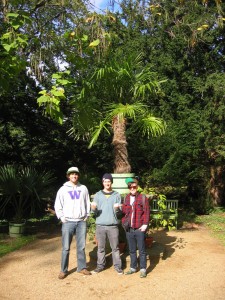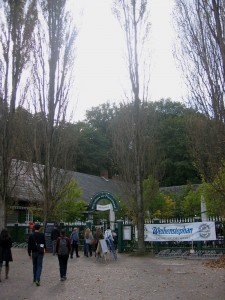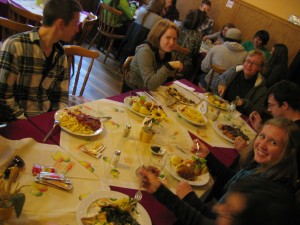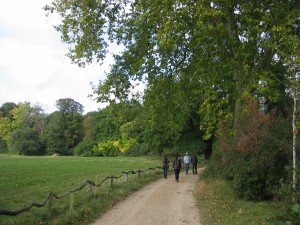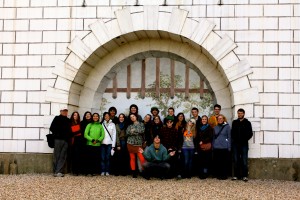A trip to Weimar & Dessau
This weekend we traveled to the beautiful city of Weimar, home of Goethe, Schillar, Liszt, and the birthplace of the Bauhaus! Our first stop on Friday afternoon was the Bauhaus museum – a small but unique little space with treasures from the first years of the school’s existence. Unfortunately the Bauhaus school was forced to leave Weimar after the Nazi party gained power in the state of Thüringen in 1924.
This opened a difficult chapter in Weimar’s history, and on Saturday we visited the nearby site of Buchenwald concentration camp.
The most striking thing one finds on entering the camp is the view: the camp is set in the middle of the forest (Buche means “beech” and Wald means “woods”), on a hill that allows a view across the valley. It’s difficult to believe that such horrible things could transpire amidst such natural beauty.
The original barracks are no longer extant – most are now marked with dark loose stones, but one has been rebuilt in its original form. One of the few other buildings still standing on the grounds is the crematorium, which was strangely located adjacent to a little petting zoo built for the children of the SS.
The Goethe Eiche – Goethe’s Oak – was an oak tree left standing in the camp by the SS. The prisoners named it in remembrance of Goethe’s trips to this same forest. It was damaged in an Allied bombing in 1944 and subsequently chopped down.
Buchenwald was also used as a Soviet internment camp after the war. It’s thought that about 7,ooo people died during this time in the camp’s history, and they were buried in unmarked graves in the woods surrounding the site. Because Thüringen became part of East Germany, the deaths were not acknowledged during the Cold War. The fall of the Berlin Wall finally allowed the victims’ families to speak up and publicly remember their relatives.
The Soviets left another highly visible legacy: a huge memorial to the camp’s liberation, on a hill overlooking Weimar. Buchenwald’s many layers of tragic history gave us much to consider …
The class was free to spend the rest of the day exploring the town. Chance and I took a stroll through the park and admired the “Roman House,” the amazing landscape and the first Bauhaus demonstration house, the Haus am Horn.
Today we left Weimar and headed back to Berlin, with a stop in Dessau to visit the most famous site of the Bauhaus, their school building, designed by Walter Gropius and built in 1925-6. We got a fantastic tour from a very knowledgeable and enthusiastic guide, and I think our students might almost be convinced that Modernism isn’t all horrible … (those of us who study architecture are already sold).
We couldn’t have asked for a more lovely day to see this truly seminal piece of architecture. This week we dive into the study of the specter that haunts both the history of the Bauhaus and Buchenwald: the Nazis and their influence on Berlin and Germany.
A day in Potsdam
Our day trip to Potsdam featured more of our favorite 19th-century designer, Karl Friedrich Schinkel. (You probably think we’re just obsessed with him, but believe us – he truly was great!) We began at the St. Nikolaikirche near the city center. It was begun according to plans by Schinkel, but finished by his student Ludwig Persius.
Berlin isn’t the only city that is rebuilding past monuments – here you can see that Potsdam is also busily rebuilding its royal palace (across from the Nikolaikirche), as a home for the state parliament. Meanwhile, East German buildings on the other side of the square are slated for demolition and replacement.
A trek across Potsdam and through Sanssouci park brought us to another Schinkel site, this one built for a very elite audience – the crown prince.
Schinkel built a tiny summer palace (really the size of a summer home) for the prince, who was a prolific artist and designer himself. Together, they fashioned what the prince referred to as “Siam” – a utopian space filled with rich symbolism, much of which is now lost on those of us without the proper classical education!
Schinkel also designed a house for the court gardener, which later became a billiards room, tea lounge and general garden leisure space for the prince and his friends.
We took some leisure time ourselves – to contemplate the connection between human constructive activity and that of nature, as Schinkel intended – before heading off on our own walks through the rest of Sanssouci park. Next week: Berlin around the turn of the century!
A day on the Pfaueninsel
On Friday we took a trip about an hour outside of Berlin to a magical place called the Pfaueninsel – Peacock Island – for a class retreat. Our goal wasn’t to engage with official historical narratives so much as to relax and be together in a beautiful natural setting!
After riding the S-Bahn to Wannsee, we got to ride on a classic double-decker bus that took us through the woods to the entrance to the island.
Our first stop on the island was Schloss Pfaueninsel, erected for King Friedrich Wilhelm II and his mistress Wilhelmine Enke in the 1790s. Built from wood, it’s supposed to look like a white ruin on the island of Capri!
Of course, the first thing everyone looked for on the island were the eponymous peacocks – and the students found, and were chased aggressively by – a whole flock of them!
The island contains no end of sublime vistas and interesting architectural follies. It was formerly one of the many pleasure grounds of the Prussian royalty, replete with ridiculous attempts at the picturesque. For instance:
A “dairy” in the form of ruined Gothic church, where the king and his mistress could first play at milking the cows before going upstairs to drink milkshakes in an ornately decorated salon!
The island has some quirky modern works, too …
… and there are allusions to buildings that are no longer there, as well. A palm house designed by Karl Friedrich Schinkel once stood on this site, but it burned down in the late 19th century. A pleasant little palm garden pays homage to the absent building.
Though it was sunny, the weather was quite cold and windy. By lunchtime, we were thankful to sit down in the cozy Wirtshaus zur Pfaueninsel and enjoy some delicious home-style German food. Schnitzel, wild boar, Klopse (meatballs), Flammkuchen and pumpkin soup were all on the menu, accompanied, of course, by generous helpings of potatoes!
As we headed home, I couldn’t help thinking about the royals who had once frequented the island. What were their lives like? How would they have experienced the space? We’ll be finding out more about how they lived this coming week, when we visit Park Sanssouci, home to several royal Prussian palaces.
tags
the author
I'm a doctoral student at CUNY Graduate Center. I'm thrilled to be teaching the CHID Berlin program with Prof. John Toews! You can contact me at naraelle [at] gmail.com, or find out more about me at www.naraelle.net.
Blogroll
- Annie Holden's blog
- Cassie Hoeprich's blog
- Dominic Barrera's blog
- Janet Williams's blog
- Mariah Alderete's blog
- Melissa Au's blog
- Robert Hampton's blog
- UW Students Study Abroad Our students Natalie and Cassie are contributing to the official IPE student blog this fall!



